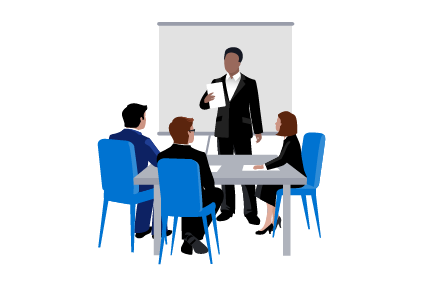How Do The Best Sales Training Activities Drive Results?

Using tried and tested sales training games and activities can allow salesforces to achieve better results. So, what makes a sales activity effective? Let's look at some of the hallmarks found in some of the best games used in sales training.
How was your company’s sales event last year? Was it the same tired and tedious talk about the numbers plus a few group exercises? Too often we hear sales forces complaining of events and training that are low energy and don’t change behavior.
At the same time, managers criticize low training ROI (return on investment). Plus, most reps forget their training and slide back into past behaviors within weeks.
So how can sales leaders and facilitators improve on sales training outcomes? Using tried and tested sales training games and activities can allow you to achieve better results. So, what makes a sales game effective? Let’s look at some of the best sales training ideas, and the features found in some of the best games used in sales training.
Features and Benefits of Sales Training Activities & Games
Great training uses entertainment to make the learning experience more memorable. Games offer a host of benefits not available with traditional classroom settings. These benefits include:
 Better Decision-Making
Better Decision-Making
Negotiation is about making better decisions and persuading others to go along with your decisions. Skills that typically take months to years for sales teams to master can now be achieved in a much smaller timeframe through enhanced sales training.
Learning through practical activities allows sales reps to practice and more rapidly improve on their decision-making processes. Ideal is having reps practice under the guidance of experienced instructors. That way, reps receive qualified guidance on where they performed well and where they made poor decisions at each step of the way.
Quick Analysis
The measure of the success of your negotiation is in the value you create. In sales negotiation, that success often means the deals that you don’t lose and closing deals at higher margins. In procurement, success likely means cost savings.
Games allow sales reps to measure their performance in real time. The faster the feedback, the higher the retention. Also, the more likely the behavior change. In addition, the best tech-based games offer point-scoring to easily gauge the success of a sales team or strategy.
Cost Savings
Classroom-based coaching and training can be expensive. Typical costs include course fees, hotel and travel, and the hard-to-measure opportunity cost of time away from customers. Sales simulation games offer training and coaching at a fraction of the cost since online delivery is possible, meaning no travel costs and much less time spent away from revenue-producing calls and emails.
Nonfinancial Measures
It can be difficult to measure the nonfinancial performance of a sales team through traditional methods. With simulation games, participants can analyze and measure nonfinancial KPIs (key performance indicators). KPIs may include:
- Engagement levels
- Customer relationships
- Sales cycle times
- Team synergy
The best sales games convert nonfinancial goals into a scoring model. This aids sales professionals in learning the tradeoffs against financial goals.
It’s relatively straightforward to measure revenue and margin. However, more challenging is placing a value on risks, upselling and cross-selling, recurring high margin aftermarket revenue, warranty extensions, and persuading a big account to be the first to try your new service or product.
Risk-Free Training
On the job, you learn largely by making mistakes. This is expensive and can be damaging to the company. Sales activities allow participants to make mistakes that cost the business nothing. This risk-free environment translates into sales professionals being more open to trying out new skills and toolsets, resulting in more confidence and higher competence.
Onboarding and Coordination
Your organization may hire sales personnel in different locations. Your sales team may also be working varied roles across your sales funnel. Coordinating the training of different roles spread across many locations is challenging for large B2B corporations.
Sales games offer a quick way to onboard new members and get them up to speed. New members can quickly become familiar with their teammates, products and services, and the hierarchal structures within the business. Simulations not only make clearer what is expected, but the rapid feedback makes subtle and often vital distinctions clear.
Sim-based games also clarify the roles and responsibilities of other team members and stakeholders. Games can teach reps to coordinate efforts on lead nurturing, lead prioritization, coordination with inside sales, team preparation, team roles, and keeping the momentum rolling.
 Pack of Huskies or Herding Cats?
Pack of Huskies or Herding Cats?
How does your organization measure the sales force’s value? Most sales departments are not sufficiently conscious of their biases, resulting in sales reps pushing and pulling in different directions. This leads to disparities in results across different products, services, teams, and offices.
To witness whether your KPIs and reward structures are driving the right sort of decisions, give your team a practical role-play. It won’t take long as you watch and listen for the results.
Participants can analyze:
- Which methods of qualifying leads is most effective?
- Where is time being wasted on ineffective processes?
- Who has the best skills for each part of the process and in which roles?
- Where are each sales professional’s skill gaps or opportunities?
- Who has a tried and tested success method that’s been locked away in silos?
- What are the best stories for your sales organization?
- What’s more important, market share or margins? (and other tough choices.)
- What’s your star performer’s magic formula?
- What are the best ways to respond to your most typical objections?
How to Use the Best Sales Training Games
Do sales training games actually deliver results? Based on sales forces’ online feedback, the answer is a resounding yes. So how do these sales teams use sales activities to gain the most benefits? Here are the top ways you can use sales training ideas and activities for better results.
 Integrate Games with Other Learning Modes
Integrate Games with Other Learning Modes
A common training scenario sees a sales leader introduce a new sales technique to their team. The leader may explain the technique patiently and passionately. The leader may even role-play to ensure the team are focused and engaged, and that they understand with no objections.
However, when the leader next accompanies their team on sales calls, they find that the sales reps are using the same old techniques. This is the danger when not including immersive elements in your training.
When teams don’t participate in the lessons they’re observing, they’re unlikely to effectively integrate the lessons. Rather than the learned concepts sticking, leaders report seeing what social scientists have termed “snapback” – where sales teams quickly revert to their old trusty habits.
Sales training facilitators should include role-play with other forms of training, like traditional learning or mentoring. Allow your sales force to practice new techniques in a safe, simulated environment, and then move on to provide further mentorship.
When planning lessons, facilitators should add practical activities into each key learning area. Games can work to consolidate understanding. In addition, games are great for team building and motivation, as well as for acting as a mode of assessment. Sales training activities increase engagement while reinforcing taught content and increasing the team’s capability.
Make Use of Dynamic Tailored Scenarios
An increasing number of companies opt to have a simulation scenario tailored to their sales environment. While generalized sim negotiation scenarios offer value, it’s important to ensure simulations deliver on a company’s real-world challenges. Allowing the application of your preferred sales methodology is crucial, too.
Customization helps to develop the right sales skills for your organization. When customizing your organization’s sales training games, here are some points to ponder:
- Does the activity offer relevant measures of realism for my sales force?
- Are the intended training outcomes clarified and well defined?
- Is the level of ambiguity manageable for this group?
- Do the participants show an understanding of their individual roles?
- Does the activity introduce practical problem-solving techniques?
- Does the activity allow your team to use their sales tools and processes?
- Does the activity encourage collaboration and competition between participants?
- Will follow-up activities be desirable?
- Is teamwork with defined roles possible?
- Will you be able to score or otherwise compare paired negotiators or teams to each other?
Foster Collaboration and Positive Competition
Sales reps are often competitive by nature. In sales departments, many reps try to outdo each other as they chase big ticket sales and quotas. Competition is healthy, but can hurt performance if taken too far. Negative competition can lead to regular conflicts that suck up the team’s time and energy.
Sales games often lead to positive competition. Ideally, team leaders need to foster positive competition and collaboration rather than “me-first” approaches.
A sales training game can enable team leaders to guide members in placing a premium on cooperation. For example, create an activity where the team can’t close a deal unless each member of the team contributes. For the deal to proceed, members have to update the team on progress, give each other advice, and find solutions to problems.
Through games, team members can identify their own behaviors that may be promoting negative competition. For example, does your harsh criticism make your colleagues want to sabotage your efforts? With collaborative activities, participants focus on up to four outcomes:
- What the participant wants
- What the colleague wants
- What other competing teams want
- Ways to achieve all for the company’s betterment
As games reinforce these outcomes, it becomes a habit for all participants. In turn, reps start to seek better collaboration to close more deals.
 Utilize Immediate Feedback
Utilize Immediate Feedback
Post-simulation discussions lead to deeper learning, and promote critical thinking. Without feedback, participants receive little to no direction for improvement.
Simulation games provide feedback that’s both instant and personalized through point-scoring and replays. According to Training Magazine, research shows that feedback is most effective when it is instant.
Quick feedback prevents the internalization of wrong behaviors and adoption of poor habits. Quick feedback connects new and better ways of doing things to the situation at hand, dramatically boosting chances of these new and better ways taking root. Ideal is allowing sales game players to then immediately get another chance to act on after-play feedback by practicing the recommended behaviors.
Facilitators should ensure that feedback is relevant to the sales team’s real-world scenarios. In particular, feedback should provide clear explanations of why a particular alternative is better than the one the player took. Only then can the participant understand how their problem-solving patterns can impact their real-world sales environment.
With enough paired sales negotiators or teams, you will have the opportunity to compare and contrast groups who took different paths and approaches. This makes lessons more real, and fosters valuable and more practical discussions.
 Improve Competitive Advantage
Improve Competitive Advantage
Clearly the name of the game is for your company to seize a competitive advantage over your competition. Through regular practice during sales activities, reps can improve their performance to the point where sales becomes your company’s competitive advantage.
With sales games, participants learn and practice how to develop deeper customer relations. Deep relationships stand out and lead to advocacy marketing. As reps practice relationship-building, more clients may be willing to endorse the company and its products.
When sales reps are better than the competition at understanding the customer’s biggest pain points, you have the seeds of beating the competition out of deals. When your team can put together your value proposition and sell your value in ways that the customer agrees exceeds their needs, you can charge a premium.
When your team can navigate sales negotiations to leverage the value they’ve created to convert at higher margins, you not only grow your top line; you grow your bottom line as well.
Track and Assess Performance
Want your team to consistently hit it out of the ballpark, rather than enjoying a see-saw result? Then use follow-up activities to measure comprehension and to reinforce lessons learned. With point-scoring, your team can measure the value left behind by sales reps so you can rapidly fix blind spots. Monitoring and assessments enable the team to more consistently enjoy an outsized win or a true win-win.
Create Friendly Sales Competitions
Sales contests enhance sales training if structured in a way that boosts collaboration alongside competition. Some extra features beyond competition may include elements of surprise, urgency, and interdependency.
For example, the “pair selling” game teams up participants in ways they are not normally. For instance, pair experienced reps with newcomers, high-performing reps with low performers, or relationship sellers with analytical sellers.
The goal of an activity debrief can be to introduce one-on-one mentorship or to identify each other’s brilliant moments through the sharing of ideas.
Create and Reinforce New Habits
Participants and instructors are often haunted by a lifetime of old habits. Most training is one-off events providing short-term intervention. The risk to guard against is most participants reverting to old habits within a few short weeks after the training event.
For tools and skills to stick, they need regular reinforcement. That means revisiting lessons and tools weeks and months after the training course. At the very least, introduce a segment of your sales meetings or conference calls where you discuss how you sold or negotiated, as opposed to the results achieved.
Continue to regularly practice the most useful parts of the coaching sessions through role-play exercises and case studies.
 Last Word – Training Activities & Games Boost Sales Skills
Last Word – Training Activities & Games Boost Sales Skills
Sales games used in training can work to build your team’s competence and confidence. With point-scoring and immediate feedback, simple sales training ideas can be transformed into invaluable tools for uncovering the strengths and weaknesses of participants. Regular practice can be fun and is ideal for modeling new behaviors.
Through careful customization, sales forces can practice new skills in realistic yet safe environments that mirror on-the-job scenarios. Like a student pilot in a flight simulator, sales reps can practice handling diverse customers and market scenarios with different types of pressures. If anyone crashes and burns early on, you can simply give them another life to restart the game over.
Trainees can repeat scenarios until they know instinctively how to respond to all sorts of conditions. This is how martial artists train – the moves become more than habitual; they become instinctive.
Simulations speed up soft skill training while improving memory retention. Simulation games can be made more effective by facilitators adding tutorials, videos, feedback channels, quizzes, and many other components that enhance the learning experience.
YOU MAY ALSO LIKE







